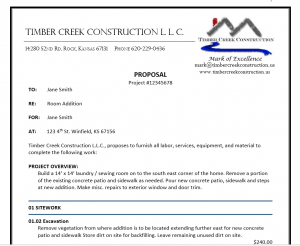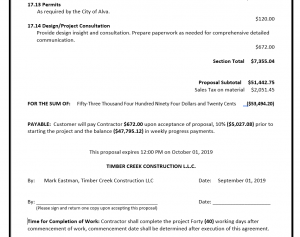This Is A Critical Part of Clear Communication
We began this “Blueprint for Building a Better Proposal” series with communication and the problems that occur when it’s done poorly or not at all. This is without a doubt the area where most contractors struggle. It doesn’t have to be this way.
Communication is the most important part of the proposal process.
Things that are unfamiliar seem overwhelming. This is true for both the customer and the contractor. The customer when not understanding what the contractor is talking about and contractor when not having a system for preparing proposals.

Our “Blueprint for Building a Better Proposal” system has specific pieces and steps for simplifying the process.
Last week we went through Step 1 – Gathering Information. This is where the customer’s why is uncovered, and the physical information is gathered and recorded. Here, we’ll breakdown Step 2 – Preparing the Scope of Work.
What is a Scope of Work?
A Scope of Work, …clearly defines the project requirements, milestones, deliverables, end products, documents and reports that are expected to be provided by the vendor. It helps in the smooth functioning of a project/work contract wherein both parties can avoid ambiguities and situations leading to dispute. It is the first step to building a mutually beneficial collaboration between a vendor and his customer. From a Udemy blog post written by Richa
According to Juan Rodriguez’s The Balance Small Business article, “Must-Have Items on a Construction Scope of Work”, the basic elements…of a scope of work document describes all of the work to be done on a project, who is responsible for completing the work, how the work must be performed (techniques used), and what materials will be used.
Communication needs be simple and direct while explaining clearly and thoroughly.
Writing out the description of work to be done in terminology that both the customer and the contractor understand is key to clarity. It needs to include enough specifics to be thorough without being too technical. Communication isn’t any good if it’s confusing.
EXAMPLE PROJECT:
When meeting with customer Jane Smith we found out that she wanted to add on a laundry/sewing room. She loved to sew and did a lot of it. Currently she used the table in the main floor dining room and the sewing machine in the basement. Her washer and dryer were in two separate closets in the master bathroom. This made for an inconvenience when sewing or doing laundry.
Once we’ve determined the why and gathered the pertinent information…

…it’s time to prepare the scope of the work.


Once this process has been finished for the complete project, we’ll have a Scope of Work ready to be transferred to the Proposal template.

Next, we’ll start figuring out the prices for individual items using the Worksheet and Data Base.



















 He asked if this was a problem. My partner told him no, it wasn’t a problem. Guess what…
He asked if this was a problem. My partner told him no, it wasn’t a problem. Guess what…
 What if I told you that there is such a system and you could have it? There is and it’s going to become available in the next few months. Over the next several weeks we are going to breakdown the system, go through the different documents and processes in detail and explain how it works.
What if I told you that there is such a system and you could have it? There is and it’s going to become available in the next few months. Over the next several weeks we are going to breakdown the system, go through the different documents and processes in detail and explain how it works.


 Trying to DO EVERYTHING for EVERYBODY has been something that I have always struggled with. There’s just so many great things to be done and someone needs to do them. It never works any time anybody tries it. We have to learn to say no.
Trying to DO EVERYTHING for EVERYBODY has been something that I have always struggled with. There’s just so many great things to be done and someone needs to do them. It never works any time anybody tries it. We have to learn to say no.



 Quality, honesty and integrity cover this part of the list. These are character issues. They are about choosing to give as much importance to someone else’s needs as I do my own.
Quality, honesty and integrity cover this part of the list. These are character issues. They are about choosing to give as much importance to someone else’s needs as I do my own. The entire issue of construction projects falling apart is unnecessary and unacceptable.
The entire issue of construction projects falling apart is unnecessary and unacceptable.







 Cost overruns – You’ve saved and/or borrowed the money you predict you’ll need to do the upcoming construction project. You get an estimate of what it’s going to cost. Sure, it’s more than you expected, but that’s alright it will be worth it in the end, right. Then you get the final bill and it’s a lot more than expected. Now what? Where are you going to find the additional money?
Cost overruns – You’ve saved and/or borrowed the money you predict you’ll need to do the upcoming construction project. You get an estimate of what it’s going to cost. Sure, it’s more than you expected, but that’s alright it will be worth it in the end, right. Then you get the final bill and it’s a lot more than expected. Now what? Where are you going to find the additional money?



 This problem can, and should, be addressed before any actual construction begins. The underlying issue with any disagreement is, different people seeing things differently. A good contractor’s job is to sort through these differences and develop a clear picture of the project scope, design, schedule and price.
This problem can, and should, be addressed before any actual construction begins. The underlying issue with any disagreement is, different people seeing things differently. A good contractor’s job is to sort through these differences and develop a clear picture of the project scope, design, schedule and price. The first four…half of the list, are communication related. Good communication takes time and effort. Time and effort translate into additional cost. Additional cost means your project’s price is higher. Price is important and often leads to choosing a lower bid. Full circle back to the importance of communication. If you are aware of the differences and are presented a clear plan, you can make the best decision for you and your project.
The first four…half of the list, are communication related. Good communication takes time and effort. Time and effort translate into additional cost. Additional cost means your project’s price is higher. Price is important and often leads to choosing a lower bid. Full circle back to the importance of communication. If you are aware of the differences and are presented a clear plan, you can make the best decision for you and your project.



